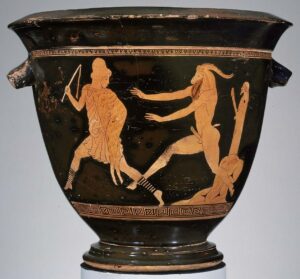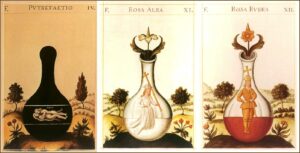
Not too long ago I had a disturbing dream. The dream accomplished what dreams often do— illuminate for the dreamer unconscious feelings that are hidden to the waking ego. Carl Jung believed dreams serve a compensatory function: to balance our conscious attitudes, they present symbolic images that complement and enlarge how we experience ourselves in daily life. A conceited person full of himself, for instance, might dream he was an ant. In my dream, I cradled a dog while its life ebbed away. I knew I couldn’t save this beloved creature, and as I rocked the dog in my arms, I saw in its eyes how it felt I had betrayed her. When I woke, I knew there was no escaping what I felt: my sense of helplessness and repressed sorrow over our “dying” society, a reality I needed to embrace.
Here is the backstory to that dream: during the early months of COVID-19, I had surprised myself by remaining relatively calm. What anxiety I had I succeeded in confining to an hour of nightly news. But as the viral pandemic grew into a more diffuse global experience of social breakdown, and the nation witnessed on video the murder of an innocent man pleading for his life, heavier emotions took over.
What my dream indicated was that beneath palpable anger and anxiety, a walled-off, unacknowledged “sadness beyond sadness” lived in my psyche. Had it not been for this powerful dream, I might have gone weeks or months being out-of-touch with those feelings. I share this personal story as a reminder that the fractured, fragmented, broken outer world influences our inner lives as well.
If you, too, find strong emotions making you feel unbalanced, please read on.
***
 “Pandemic” comes from the Greek pandemos, which means “all of us.” Related to “pandemic” are “panic “and “pandemonium” and all three words reference the mythological Greek god, Pan. Stories about Pan refer to him as the terror-awakener. Whenever Pan appeared, panic spread and grew contagious. All of us on the planet are facing inescapable, difficult, and unacceptable truths. Our current government and health care systems are straining under an attack by a powerful and unpredictable new adversary. The future is unknowable and new structures meant to stabilize society will be slow to evolve.
“Pandemic” comes from the Greek pandemos, which means “all of us.” Related to “pandemic” are “panic “and “pandemonium” and all three words reference the mythological Greek god, Pan. Stories about Pan refer to him as the terror-awakener. Whenever Pan appeared, panic spread and grew contagious. All of us on the planet are facing inescapable, difficult, and unacceptable truths. Our current government and health care systems are straining under an attack by a powerful and unpredictable new adversary. The future is unknowable and new structures meant to stabilize society will be slow to evolve.
Collectively and individually, we are in a state of transformation. If Pan, the terror-awakener, has entered into our midst, the stories assure that he is not a permanent feature of the landscape. One way to gain a new perspective on the changes we are undergoing is to view them as part of an unfolding process and not as an inevitable or fixed state of ruin. A brief overview of the ancient art of alchemy can serve as a model and a way to frame transformation and perhaps discover hope and potential betterment as an outcome of the process.
 The antiquarian alchemists were originally concerned with turning base metal, lead, into gold. What I’d like to do here is to view the great work of alchemy symbolically: as a spiritual metaphor for the transmutation of human souls from the lowest to the highest, as a breakdown of old attitudes and habits of being. The alchemists described their work as proceeding in stages identified by colors. The original four stages include the nigredo (the blackening), the albedo (whitening), the citrinitas (yellowing), and the rubedo (reddening). We won’t get into the intricacies of each stage, but let’s note that the trajectory from blackening to reddening is a process of attaining illumination and spiritual wholeness through the work of bringing the unconscious into consciousness. Not just individuals, but entire cultures can and do undergo dark ages that evolve into a golden age or an age of enlightenment.
The antiquarian alchemists were originally concerned with turning base metal, lead, into gold. What I’d like to do here is to view the great work of alchemy symbolically: as a spiritual metaphor for the transmutation of human souls from the lowest to the highest, as a breakdown of old attitudes and habits of being. The alchemists described their work as proceeding in stages identified by colors. The original four stages include the nigredo (the blackening), the albedo (whitening), the citrinitas (yellowing), and the rubedo (reddening). We won’t get into the intricacies of each stage, but let’s note that the trajectory from blackening to reddening is a process of attaining illumination and spiritual wholeness through the work of bringing the unconscious into consciousness. Not just individuals, but entire cultures can and do undergo dark ages that evolve into a golden age or an age of enlightenment.
Carl Jung spent years of intense study reading the codices of the ancient alchemists. In 1944, he published Psychology and Alchemy, and later included a section on alchemy in his Collected Works. He deeply analyzed the ascendency of Nazi Germany and the unacknowledged anger, depression, and resentment bound in the German collective unconscious as a result of the country’s humiliation after World War I. Jung would likely agree that the pandemic we are currently living through along with our increased racial strife has placed us inside the experience of the nigredo, at the beginning of the alchemical process when decomposition, dismemberment (of the culture), and putrefaction reign.
During the nigredo, changes great and small occur. Old forms decay and are dissolved into “a black blacker than black,” as when a fruit or body rots, eventually to become soil and nourish new life. We have all seen how at the right season apples drop from branches. As the natural process continues, the flesh of the apple withers and shrinks, turns soft and rotten. This allows the seeds at the apple’s core to bury into the earth where they germinate new life. The “death” of the apple provides the opportunity for the seeds to do their work.
 As a metaphor for dissolution and the dark night of the soul, the nigredo speaks to us now as we suffer a kind of collective death, despair, and disillusionment. It is a time of putrefaction and mortification—putrefactio and mortificatio—but the nigredo, as the alchemists saw it, and Jung agreed, is the beginning of the great work. It is a time of massa confusa, creative chaos. Jung would often refer to the beginning of analysis as the nigredo, that is, “dark at the beginning,” which he took from the Rosarium Philosophorum, an alchemical treatise from the sixteenth century. The Rosarium states: “When you see your matter going black, rejoice, you are at the beginning of the work.”
As a metaphor for dissolution and the dark night of the soul, the nigredo speaks to us now as we suffer a kind of collective death, despair, and disillusionment. It is a time of putrefaction and mortification—putrefactio and mortificatio—but the nigredo, as the alchemists saw it, and Jung agreed, is the beginning of the great work. It is a time of massa confusa, creative chaos. Jung would often refer to the beginning of analysis as the nigredo, that is, “dark at the beginning,” which he took from the Rosarium Philosophorum, an alchemical treatise from the sixteenth century. The Rosarium states: “When you see your matter going black, rejoice, you are at the beginning of the work.”
And isn’t it true that what drives us to seek professional help is often driven by our lives falling apart?
We are in it—a period of waiting in uncertainty and grief. Many of us, individually, know cycles of generativity alternating with fallowness and depression. We have learned that the energy that has slipped underground is not gone, but is incubating, soon to push through and renew life. If there is hope in the moment, we can turn to the next stages of alchemy. The albedo (white) and rubedo ( red) that promise renewal and a transformation of what was base and leaden into light. We can take comfort in knowing the wisdom traditions have charted a way through epochal changes, and we can have faith in our creative capacity to adapt and re-vision a more just, safe, and equitable world.
This post appeared in a slightly different form on my blog on Psychology Today. You can find all of my blog posts for Psychology Today at